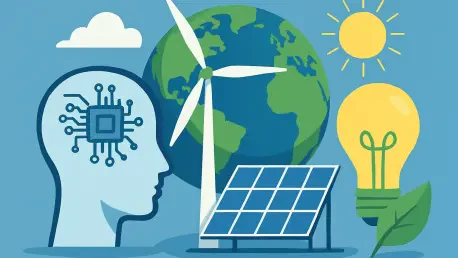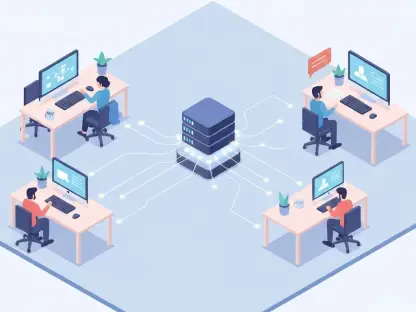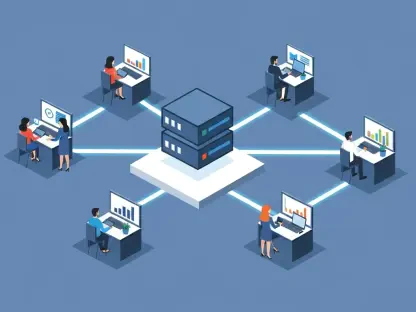As artificial intelligence (AI) continues to revolutionize industries and reshape the digital landscape, a pressing challenge emerges from the shadows: the staggering energy demands required to fuel this technological leap, which pose a significant hurdle for sustainable progress. Data centers, which form the critical infrastructure for AI systems like large language models, consume vast amounts of electricity, often at a scale that current energy grids struggle to sustain. This raises a pivotal question about whether the United States and Europe can meet their ambitious AI goals while adhering to clean energy commitments. The tension between technological advancement and environmental responsibility is palpable, with global competition adding further urgency. While AI promises innovation and economic growth, the energy bottleneck threatens to undermine progress unless sustainable solutions are prioritized. This article delves into the intricate balance between powering AI’s expansion and ensuring that clean energy can keep pace with such unprecedented demand, exploring regional challenges, innovative approaches, and systemic hurdles.
The Escalating Energy Demands of AI
The energy appetite of AI infrastructure is nothing short of staggering, posing a significant hurdle for both the US and Europe as they race to maintain technological leadership. A single query on platforms similar to ChatGPT can consume as much power as running a lightbulb for 20 minutes, a seemingly small figure that balloons when scaled to millions of daily interactions. Data centers, the heart of AI operations, already account for a notable slice of total US energy consumption, with projections indicating this could triple by the decade’s end. This exponential growth places immense pressure on existing power grids, many of which were not designed for such intense, localized demand. Without rapid advancements in energy generation and distribution, the risk of blackouts or skyrocketing costs looms large, potentially stalling AI-driven progress.
Compounding this challenge is the clash between immediate energy needs and long-term sustainability goals endorsed by governments and tech giants alike. Companies such as Google, Amazon, and Microsoft have made bold pledges to transition to renewable sources, yet the reality of powering data centers often leads to reliance on fossil fuels as a temporary measure. In the US, discussions around expediting permits for gas-powered facilities signal a potential retreat from green ambitions, while Europe grapples with similar trade-offs amid delays in renewable energy projects. This discrepancy highlights a critical gap: the infrastructure needed to support AI is outpacing the development of clean energy solutions, forcing a reevaluation of priorities in the face of relentless digital expansion.
Transatlantic Challenges and Global Competition
Across the Atlantic, distinct regional disparities reveal uneven capabilities in addressing AI’s energy conundrum, with the US holding certain advantages over Europe. In the US, states like Texas have become hubs for data center growth thanks to abundant renewable resources and regulatory flexibility that streamline project approvals. However, even with these benefits, aging grid infrastructure remains a persistent issue, with a significant portion of power interruptions stemming from outdated distribution networks. Rising electricity costs in over a dozen states further complicate the landscape, as the rapid proliferation of data centers outstrips the pace of new power plant construction. This dynamic underscores the urgent need for coordinated investments to modernize energy systems before demand spirals beyond control.
Europe, on the other hand, faces steeper obstacles that threaten to widen the competitive gap with the US and other global players. The region anticipates a sharp increase in data center electricity demand over the next five years, yet grid enhancements and new energy generation capacity are progressing at a frustratingly slow rate. Bureaucratic delays in permitting processes, coupled with structural limitations in transmission networks, hinder the integration of renewables like offshore wind and nuclear power. Meanwhile, China’s state-driven approach—bundling clean energy, land, and digital infrastructure into cohesive industrial zones—presents a formidable contrast. This integrated strategy positions China as a frontrunner in the AI race, exposing the fragmented policies in the West as a critical vulnerability that must be addressed to maintain global standing.
Emerging Innovations in Energy Solutions
Despite the daunting challenges, innovative efforts in both regions offer a glimpse of potential pathways to align AI’s energy needs with clean power objectives. In Europe, the Nordic countries stand out as a model, with their access to low-cost, renewable energy making them ideal locations for AI training facilities. France, leveraging its substantial nuclear energy capacity, is exploring the concept of nuclear-powered data hubs as a stable, low-carbon solution. Additionally, smaller nations like Moldova are demonstrating remarkable agility by piloting real-time energy management systems that optimize grid interactions with AI infrastructure. These initiatives, while promising, are often constrained by geographic or scalability issues, limiting their immediate impact on broader energy challenges.
Across the ocean, the US is also experimenting with creative approaches to mitigate the energy strain caused by data centers. Concepts such as heat reuse, where excess warmth from data centers is repurposed to heat public spaces like swimming pools, are gaining traction in certain locales. Partnerships with firms developing small modular reactors represent another frontier, offering the potential for compact, efficient power sources tailored to AI hubs. Yet, these innovations remain in early stages, often confined to specific regions or projects, and face hurdles in regulatory approval and widespread adoption. While such efforts signal hope, they underscore the reality that piecemeal solutions alone cannot address the scale of AI’s energy demands, necessitating broader, systemic change to achieve sustainable progress.
Addressing Structural and Systemic Barriers
Beyond the promise of innovation, deep-seated structural issues in energy infrastructure pose persistent barriers to powering AI with clean energy. Outdated transmission lines and overburdened interconnectors are ill-suited to handle the concentrated energy demands of data centers, often resulting in inefficiencies or bottlenecks. In both the US and Europe, the lack of strategic zoning to position data centers near abundant clean energy sources exacerbates the mismatch between supply and demand. This disconnect reveals a fundamental flaw: while AI technology races forward with cutting-edge advancements, the foundational systems of substations and power distribution remain stuck in the past, unable to support the digital revolution at the required pace.
Tackling these systemic shortcomings requires a shift toward comprehensive, industrial-scale policy frameworks that prioritize alignment between energy and digital strategies. Investments in grid modernization, including cross-border interconnectors in Europe and updated distribution networks in the US, are essential to ensure reliable power delivery. Moreover, establishing clear pricing mechanisms and zoning policies could incentivize the placement of data centers in areas with surplus renewable energy, reducing reliance on fossil fuels. The complexity of these challenges demands collaboration between governments, utilities, and tech companies to share costs and responsibilities. Without such coordinated action, the gap between AI’s ambitious goals and the reality of energy infrastructure will continue to widen, risking both economic and environmental consequences.
Paving the Way for a Sustainable Digital Era
Reflecting on the journey to balance AI’s growth with clean energy, it became evident that neither the US nor Europe was fully prepared for the energy crisis that accompanied this technological surge. Strained grids and soaring data center demands exposed vulnerabilities in infrastructure that had long been overlooked. While regional disparities and global competition with nations like China intensified the stakes, the struggle to uphold sustainability commitments amid urgent power needs remained a defining tension. The path forward has been littered with obstacles, from bureaucratic delays to outdated systems, yet it also illuminates the necessity for transformative change.
Looking ahead, actionable steps emerge as critical to bridging this divide. Policymakers need to prioritize strategic zones where clean energy and data centers can coexist, supported by streamlined permitting for integrated projects. Investments in grid expansion and innovative solutions like battery storage hold promise for stabilizing supply. Transatlantic cooperation also stands out as a vital component, ensuring shared learning and resources to meet global challenges. Ultimately, the digital future hinges on a reimagined energy landscape, one that demands urgency and bold collaboration to turn ambition into reality.









